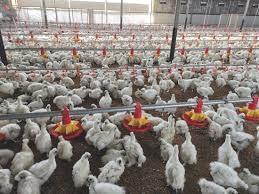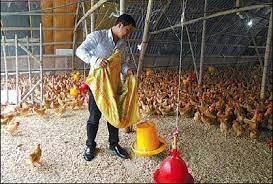 According to the USDA-FAS GAIN report CH 2022-0011 released on January 28th China will produce 14.3 million metric tons of chicken meat in 2022. Imports will attain 800,000 metric tons offset by exports of 460,000 metric tons. Human consumption, assuming a population of 1.4 billion will amount to 23.1 pounds per capita (10.5 kg). The USDA report classifies chicken meat production in China among white-feathered broilers representing 50 percent of production, traditional yellow-feathered broiler at 30 percent and hybrids and spent hens the remaining 20 percent. The figure of 14.3 million metric tons does not include consumption of other types of poultry including ducks, geese and guinea fowl. The proportion of meat consumed from domestic animals in China is estimated at 65 percent pork, 22 percent poultry of all types, eight percent beef and five percent mutton and other species.
According to the USDA-FAS GAIN report CH 2022-0011 released on January 28th China will produce 14.3 million metric tons of chicken meat in 2022. Imports will attain 800,000 metric tons offset by exports of 460,000 metric tons. Human consumption, assuming a population of 1.4 billion will amount to 23.1 pounds per capita (10.5 kg). The USDA report classifies chicken meat production in China among white-feathered broilers representing 50 percent of production, traditional yellow-feathered broiler at 30 percent and hybrids and spent hens the remaining 20 percent. The figure of 14.3 million metric tons does not include consumption of other types of poultry including ducks, geese and guinea fowl. The proportion of meat consumed from domestic animals in China is estimated at 65 percent pork, 22 percent poultry of all types, eight percent beef and five percent mutton and other species.
 Projected chicken production in 2022 will be approximately three percent lower than in 2021, in part due to increased pork consumption. Availability has increased following control of African swine fever. Partial restoration of the national hog herd has resulted in lower selling prices for chicken meat and hence reduced margins for broiler production.
Projected chicken production in 2022 will be approximately three percent lower than in 2021, in part due to increased pork consumption. Availability has increased following control of African swine fever. Partial restoration of the national hog herd has resulted in lower selling prices for chicken meat and hence reduced margins for broiler production.
Production of yellow-feathered birds in various weight categories will decline in 2022 following a multiyear trend. This is due to the fact that these birds are marketed directly to consumers in wet markets. With the advent of avian influenza transmissible to humans and reflecting government policy, wet markets are being closed in metropolitan areas reducing availability. Yellow-feathered birds are proportionally more expensive to produce then conventional white- feathered broilers or hybrids due to slow growth rate with non-competitive feed conversion efficiency.
The USDA-FAS China Station does not expect white-feathered broiler production to increase in 2022 mainly due to saturation of the market as consumers shift their preference back to pork. Higher cost for feed and lower domestic prices are driving consolidation and integration in broiler production. Independent small-scale growers are leaving production and the structure of the industry is moving towards the model in the U.S. and Brazil with new large complexes incorporating feed mills, hatcheries and either company-owned housing or contract-growing or their combination.
 Expansion within the broiler industry in China is now confined among integrators. Currently the industry is dependent on imported breeding stock that was introduced at the GP level. Following the importation of GGP level breeding stock from the E.U., China has embarked on a national program using locally produced white feathered broilers under the direction of the China National Livestock and Poultry Genetic Resources Committee. This initiative follows a government policy to make China independent of imported breeding stock and possibly compete with major primary breeders in the U.S. and the E.U. This is in accordance with the 2020-25 Five-Year Plan for the development of the National Animal Husbandry and Veterinary Industry.
Expansion within the broiler industry in China is now confined among integrators. Currently the industry is dependent on imported breeding stock that was introduced at the GP level. Following the importation of GGP level breeding stock from the E.U., China has embarked on a national program using locally produced white feathered broilers under the direction of the China National Livestock and Poultry Genetic Resources Committee. This initiative follows a government policy to make China independent of imported breeding stock and possibly compete with major primary breeders in the U.S. and the E.U. This is in accordance with the 2020-25 Five-Year Plan for the development of the National Animal Husbandry and Veterinary Industry.
Popularity of white-feathered broilers will be sustained by demand from QSRs and a desire for a cold chain provided by the expansion of supermarkets in urban and metropolitan areas. Cooked and processed chicken is increasing in availability through both supermarket and online sales.
Given the availability of chicken meat from both yellow-feathered birds for the traditional market and conventional white-feathered broilers, importation of chicken products is concentrated on feet, edible byproducts including gizzards, livers and hearts with only a small quantity of bone-in product imported from either the U.S. or Brazil.
China will continue to export chicken products mainly to Japan through joint-venture operations dedicated to presentations requiring a high level of manual labor. Given the requirements of the market in Japan, ready-to-eat and individually packaged chicken products are prepared without added salt and are stripped of fat.
In 2020, China imported 512,587 metric tons of chicken from the U.S. valued at $732 million with a unit value of $1,428 per ton. This compares to an average unit value of $995 per metric ton for all exports in 2020 suggesting a high proportion of feet. For the first eleven months of 2021, China imported 413,928 metric tons of chicken products valued at $775 million with a unit value of $1,869. This compares to total exports from the U.S. of 3,321,850 metric tons with a unit value of $1,230 again confirming that over 80 percent of chicken imports by China comprised feet.